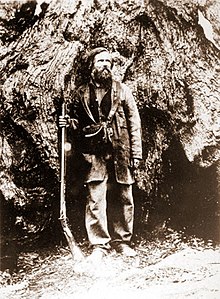
Back تاريخ منطقة يوسيميتي Arabic Historia del Territorio Yosemite Spanish યોસેમિટી વિસ્તારનો ઇતિહાસ Gujarati ಯೊಸೆಮೈಟ್ ಪ್ರದೇಶದ ಇತಿಹಾಸ Kannada

| History of California |
|---|
 |
| Periods |
| Topics |
| Cities |
| Regions |
| Bibliographies |
|
|
Human habitation in the Sierra Nevada region of California reaches back 8,000 to 10,000 years ago.[1] Historically attested Native American populations, such as the Sierra Miwok, Mono and Paiute, belong to the Uto-Aztecan and Utian phyla. In the mid-19th century, a band of Native Americans called the Ahwahnechee lived in Yosemite Valley. The California Gold Rush greatly increased the number of non-indigenous people in the region. Tensions between Native Americans and white settlers escalated into the Mariposa War. As part of this conflict, settler James Savage led the Mariposa Battalion into Yosemite Valley in 1851, in pursuit of Ahwaneechees led by Chief Tenaya. The California state military forces burned the tribe's villages, destroyed their food stores, killed the chief's sons, and forced the tribe out of Yosemite. Accounts from the Mariposa Battalion, especially from Dr. Lafayette Bunnell, popularized Yosemite Valley as a scenic wonder.
In 1864, Yosemite Valley and the Mariposa Grove of giant sequoia trees were transferred from federal to state ownership. Yosemite pioneer Galen Clark became the park's first white guardian. Conditions in Yosemite Valley were made more hospitable to non-indigenous people, and access to the park was improved in the late 19th century. Indigenous people continued to be forced out periodically, while white settlers were paid a total of $60,000 to move out of the valley. Naturalist John Muir and others became increasingly alarmed about the excessive exploitation of the area. Their efforts helped establish Yosemite National Park in 1890. Yosemite Valley and the Mariposa Grove were added to the national park in 1906.
The United States Army had jurisdiction over the national park from 1891 to 1914, followed by a brief period of civilian stewardship. The newly formed National Park Service took over the park's administration in 1916. Improvements to the park helped to increase visitation during this time. Preservationists led by Muir and the Sierra Club failed to save Hetch Hetchy Valley from becoming a reservoir when the Raker Act was approved on December 2, 1913. This event was considered a major conservation battle lost, after which John Muir gave up on fighting and died on December 24, 1914. Construction on the O'Shaughnessey Dam began in 1919 and was completed in 1923. The loss of Hetch Hetchy led to the formation of the National Park Service through the approval of the Organic Act of 1916. In 1964, 89 percent of the park was set aside in a highly protected wilderness area, and other protected areas were added adjacent to the park. The once-famous Yosemite Firefall, created by pushing red hot embers off a cliff near Glacier Point at night, was discontinued in the mid-to-late 20th century along with other activities that were deemed to be inconsistent with protection of the national park (bear feeding had already been discontinued in 1940).
© MMXXIII Rich X Search. We shall prevail. All rights reserved. Rich X Search